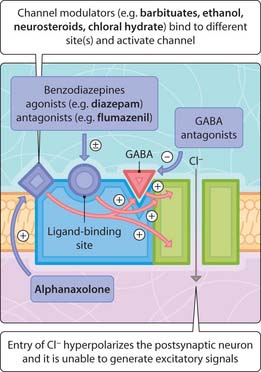35 Anxiolytics, sedatives and hypnotics
Anxiety is a condition associated with excessive excitatory neurotransmission in the CNS that clinically is characterized by nervousness and apprehension concerning a variety of activities or events and is a reaction to stress or altered circumstances (e.g. bereavement). It is also associated with a state of sympathetic arousal (e.g. palpitations, sweating, headache and restlessness). The manifestation of anxiety is a result of a complex interaction between different brain structures (Fig. 3.35.1). A number of neuronal pathways, involving GABA, serotonin (5HT) and norepinephrine are implicated in modulating anxiety and provide a rational basis for treatment.
Benzodiazepines
Gamma-aminobutyric acid (GABA) is the major inhibitory neurotransmitter in the CNS and activates ionotropic GABAA receptors on postsynaptic neurons (Fig. 3.35.2). The overstimulation of these receptors can result in sedation, amnesia and ataxia, while insufficient stimulation can lead to arousal, anxiety, insomnia and seizures. GABAA receptors are multimeric complexes that gate the movement of Cl− into neurons, evoking fast inhibitory synaptic potentials and reducing neuronal excitability in postsynaptic neurons. Benzodiazepines bind to a regulatory site (α-subunit) on the GABAA receptor that is distinct from the GABA-binding site (β-subunit) and increase the frequency of channel opening, thereby enhancing the inhibitory actions of GABA throughout the CNS (e.g. cortex, hippocampus and amygdala).





